Water retaining and head-works are imperative infrastructures for any country, providing endurance in terms of hydroelectric energy, water for drinking and irrigation purpose. In addition to this they put in a major boost to the aesthetics of that locality.
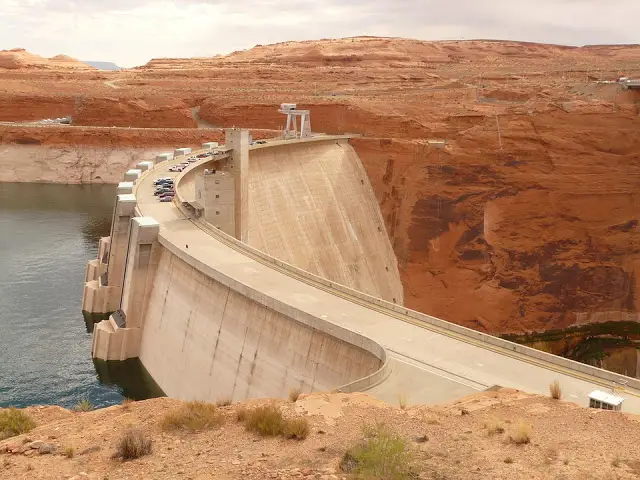 |
| Arch Dams an economical yet complex structure |
The long-term survival as well as development of any area is directly linked with the construction of quality dams and headworks. The developing countries like Bangladesh, Pakistan, India and others in South Asia region are now shifting towards the importance of these constructions.
Dam, Barrage and a weir structure is a natural or man-made obstruction or barrier build across a river in-between the two ends of the river to raise the water, called head of the structure as well produce a massive storage. A barrage is built to divert this river water into the nearby link canals by regulating head for irrigation purpose. A dam is built to utilize the head for power generation and for storage.
Dams are classified in different categories based on the type of material used; shape of the core structure; purpose of the project etc. Within these types we will now talk about Arch Dam; which is one of the unmatched, most economic however a bit complex to design and construct type of dam.
Arch dam, as the name implies, is a curved obstruction from the upstream side singly spanned that mainly carries the load of the impounded water through arch action as well as cantilever action.
Arch dams through arch action transfers portion of the load of the water thrust horizontally to the side abutments and the other portion of that load is transferred to the dam foundation vertically by cantilever action.
In the arch action, hydrostatic pressure / force of water press against the face of the arch which in return compresses and strengthens the matrix of the arch dam structure.
Arch Dams throughout the world are mostly made of concrete (either conventional concrete or roller compacted concrete); however, in the past some are also made with rubble and stone masonry.
Let us now discuss in detail about the distribution of the load by an arch dam, which is briefly explained above;
Let us consider an arch dam made up of two connected components one is series of arches and other is series of vertical cantilevers; as shown:-
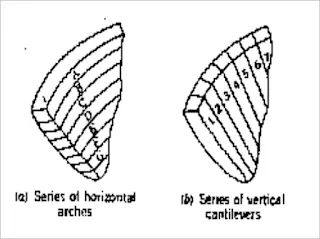 |
| Series of horizontal arches and vertical cantilevers |
The load caused due to thrust of impounded water in the arch dam is transferred to the abutments rested on solid / stable rocky side walls of the valley / canyon. Thus the load on the cantilever wall is reduced in arch dam as compared to that of the gravity dam. It is one of the major benefit due to which arch dam is considered economic.
Situations When Arch Dam is a must to use
- Arch dam is proved most economical and efficient when the width of the canyon or valley to be spanned on the river is least.
- As a major share of the impounding water thrust is taken by abutment walls resting on the sides of the canyon, thus these must be stable, strong and firm.
- Arch dam can be used most economically on a terrain where width of the valley is less than 6 times of its height or in other words B/h ratio is less than 6.
- If the area is remote such that the naturally available material are not enough to provide sufficient supply of concrete or earth-fill arch dam should be used as it needs minimum amount of construction concrete.
- The slope of the adjoining hills for the abutment should be steep i.e. more than 45 degrees.
- During the design of the arch dam it is considered that the stresses generated are upto that of allowable stresses of the concrete.
Advantages of Arch Dam – Few but long lasting
The major advantage derived from Arch dam is minimal amount of concrete / filling material required as the stresses of the thrust of water is taken care by both arch action and cantilever action requiring considerably small width at the bottom. These dams are best suited for a narrow canyon passage and can store water as well as generate electricity.
Components a Typical Arch dam is composed of
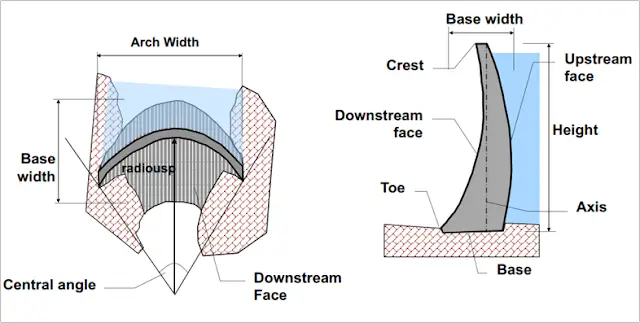 |
| Components of a Typical Arch Dam |
Above is a typical plan and cross-section of an arch dam showing typical components / parts of an arch dam.
Why arch dam is very rare in the world?
After reading till now, you might be thinking that arch dam are very economical as lesser concrete is used in it than why not they are so common?
The answer lies in the fact that the design and construction of an arch dam is very complex and requires skilled labor and strict supervision. The shuttering will be unique and costly taking major share of the cost of the dam.
Arch Dams are Classified, Really?
Shell – Arch Dam – A famous and Aesthetic marvel
Researchers have shown that greater the curvature of the arch dam in plan, the greater is the stresses on the abutments and thus lesser is the base width or thickness required. This economy can be further increased by providing curvature in the section making it a shell like or plate like structure.
Such a non-vertical and shell like arch dam is termed as double curvature arch dam or shell-arch dam.
Simple arch dams whose major part is distributed through the cantilever part of the arch dam can also be divided into different types as their faces can be either curvilinear or non-linear.
- Constant Radii Arch Dam
- Variable radii arch dam
- Constant angle arch dam
First let us discuss about Constant Radii Arch Dam
Constant Radii Arch Dam Best suited for U-Shaped Valley
The picture above clearly explains the definition of Constant Radius Arch dam; In Constant Radius Arch Dam, the radius of the outside Circular Curve (as shown in fig R1) is constant throughout the height / elevation of the dam creating a linear upstream face of the dam. However, the inner curves of the arch are of variable radii i.e. from top to bottom elevation of the arch dam the radius of the curves reduces creating a triangular cross-section of the arch dam as shown in the figure.
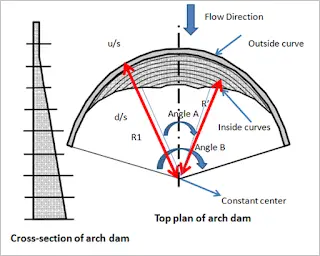 | ||
| Constant Radii Arch Dam Best suited for U-Shaped Valley |
The increased thickness of the dam at the base will take care of the proportionally increasing hydrostatic thrust of the impounding water. It is to be noted here that the outside (upstream side) circular curves are sometimes termed as extrudes while that of inside curves are termed as intrudes.
The constant Radii arch dam is sometimes referred as constant center arch dam; it is because of the fact that although the radii of the introdes decreases as we move down the elevation of the dam however the center of the curve is at the same line / point i.e. center of the curves are fixed.
There is one more term associated with the arch dam which is central angle of the arch curves. If you see at the above figure; the central angle of the introdes decreases from top to bottom i.e. maximum central angle is at the top while minimum is at the bottom.
Constant Radii or variable angle arch dams are most suitable for U-shaped valleys and is for easy construction providing vertical upstream face for efficient stress taking capacity.
Variable Radii Arch Dam Best Suited for V-shaped valley
Now after reading Constant radii arch dam you might be able to define what is variable radii arch dam. If not let me do this for you; a Variable radii arch dam is the one in which the radius of the introdoes as well that of extrodos vary along the height. Making it maximum at the top and minimum at the bottom elevations. Along with the radius the central angle also become bigger and wider making it more effective and economical.
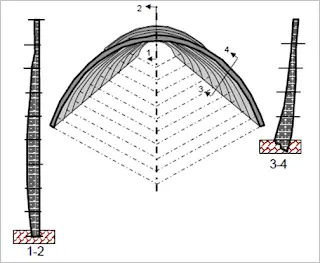 |
| Variable Radii Arch Dam |
In a typical design of such a dam, the downstream face of the dam at the central line (crown) is vertical; while at all other locations, there is a batter on both the sides except at the abutments, where again, the upstream side becomes vertical. If overhangs are permitted, due to availability of stronger foundations, then the faces at the crown as well as abutments, may be provided with overhangs, affecting saving in the designed thickness.
Evidently, since in such an arch dam, the centers of the various arch rings at different elevations, do not lie on the same vertical line; it is also known as variable center arch dam. Such dams are preferred for V-shaped valleys.
Constant Angle Arch Dams – An intermediate and most economic
The constant angle arch dam is a special type of variable radius arch dam, in which the centeral angles of the horizontal arch rings are of the same magnitude at all elevations. The design of such a dam can, thus be made by adopting best central angle of 133 degrees and 34 minutes; and hence such a dam proves to be the most economical, out of the three types of ordinary arch dams.
However, the design of such a dam usually involves providing overhangs at abutments, which require stronger foundations, and hence such a type cannot be used if the foundations are weak.
Design of Arch Dams – a complex hectic job
As already explained above that the arch dam is a complex structure which is a bit difficult to design and construct. The design procedure adopted is a hit and trial type, a hydraulic dam design is proposed which is carried out through lengthy calculations for testing and checking through different criterions thus after several tries an economical, feasible and safe working design of the dam is developed.
As far as the loads are concerned, the arch dam is designed for the same types of loads a concrete gravity dam is designed for. These loads includes :-
- Water Pressure
- Earthquake pressure
- Wave pressure
- Ice pressure
- Temperature forces
- Silt load
However it is important here to understand that importance of above mentioned factor may be a bit for some types of loads and may be not for the other one. Like in case of arch dams we know the base width is comparatively very small to that of the concrete gravity dam, thus the uplift forces will be small. Mostly in the design of arch dams the uplift forces are neglected. However stresses caused due to temperature variations like that of snow load they becomes important loads to be examined.
Arch dams are designed and engineered by three famous methods :-
- Thin cylinder theory
- Theory of elastic arches
- The trial load method
Describing these methods is actually out of scope of this post. However we will deal with them in our future posts.
For further inspiration and historic developments how arch dam is revolutionized you can read this article.

